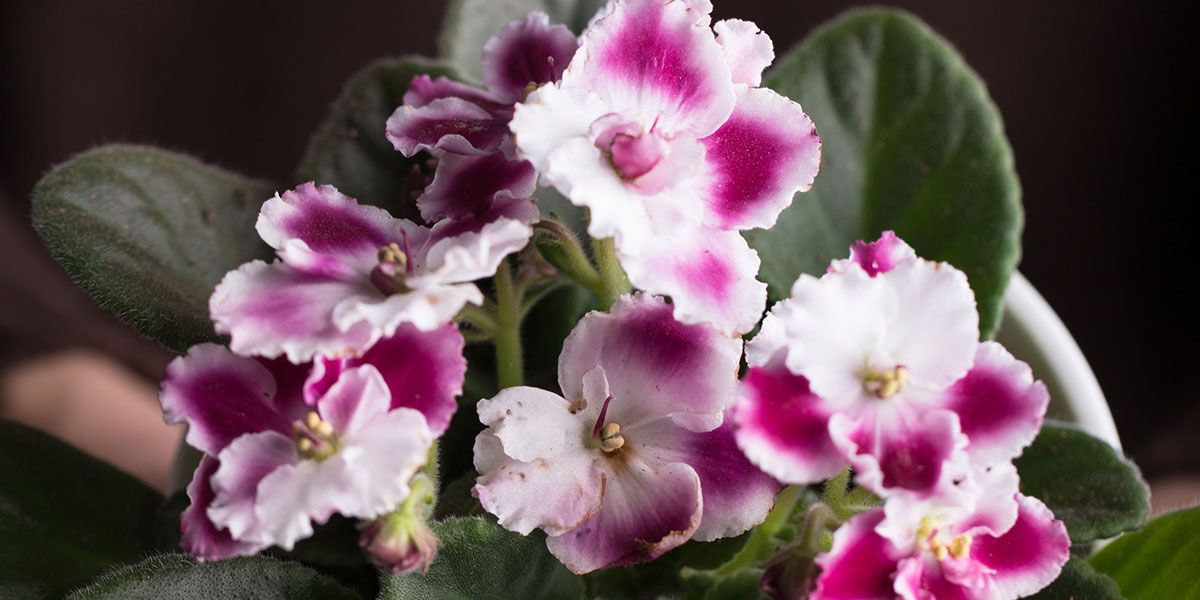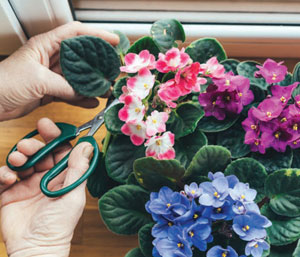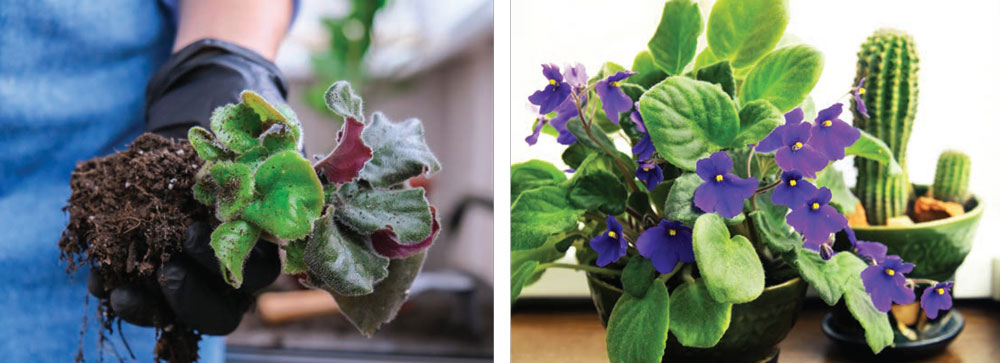African Violets | Brighten Up Your Winter Windowsills

African violets are hip again. Once maligned as a dull, old-fashioned plant, these tropical beauties have renewed status as a trendy houseplant. This isn’t your grandmother’s plant; there are new varieties being produced with variegated leaves and multicolored flowers. With deep-green fuzzy leaves and vivid flowers that bloom repeatedly during the year, African violets add vibrance and charm to your living space.
African violets hail from the tropics. Baron Walter von Saint Paul-Illaire, an avid plant collector and German colonial official in Eastern Africa, discovered them in Tanzania. He named the plant for the common violet that their flowers resemble, although they are not related. As he was traveling through fog-ridden African rainforests in 1892, these colorful flowers caught his eye. He gathered seeds and sent them to his father, a botanist in Germany, to propagate. Quickly gaining popularity, the African violet flourished into hundreds of clones and hybrids that continue to be grown today.
African violets bloom in clusters of flowers, in colors from whites to pinks to purples, with small yellow centers. They come in many sizes from small (4 to 5-inch pot) to large (16 inches or bigger) so depending upon space, try one, or grow a collection.
Violets are easy to maintain if you give them what they need. Consider these tips to keep them healthy:
- Keep them in a warm spot (65-75 degrees during the day and at least 55- 65 at night).
- Bright, indirect light is best, although during the short, light days of winter, they do fine with some direct sun.
- To encourage lots of blooms, keep them slightly root-bound; don’t repot them more than once a year, or every few years for some varieties.
- Water from the bottom. Their fuzzy leaves don’t like water sitting on them, so put a saucer under a pot that has drainage holes. Provide enough water in the saucer so the soil soaks it up and is slightly moist but not soaking wet. Allow the soil to dry before filling the saucer again. Misting the flowers is good.
- Another option is to fill a tray with pebbles and water, and place several containers of violets on top. While you should not let the plants touch each other or sit in water, the tight grouping helps keep humidity high, and plants can absorb water as they need it from below.
- If leaves get dirty, brush them lightly with your fingers or an old soft toothbrush to keep to clean them. When leaves dry and shrivel, cut them off at the stem and discard.
- Fertilize as often as every two weeks with a high phosphorous plant food, or one made especially for African violets. Cut back feedings if the plant seems listless. It is easier to overfertilize African violets than to underfertilize. They bloom well with the right light and moisture content even with infrequent fertilizer.
Practical matters
 It is time to replant an African violet when the leaves start to wilt, or the neck of the plant grows tall and leggy. This signals that the soil needs to be replaced. Select a pot 1 to 2 inches larger in circumference than the current one. Choose a wider—not deeper—container, as African violets have shallow roots. You can purchase soil made especially for these plants, or combine 1/3 potting soil with 1/3 peat moss and 1/3 perlite or vermiculite. These plants favor loose, well-drained soil amended with organic matter.
It is time to replant an African violet when the leaves start to wilt, or the neck of the plant grows tall and leggy. This signals that the soil needs to be replaced. Select a pot 1 to 2 inches larger in circumference than the current one. Choose a wider—not deeper—container, as African violets have shallow roots. You can purchase soil made especially for these plants, or combine 1/3 potting soil with 1/3 peat moss and 1/3 perlite or vermiculite. These plants favor loose, well-drained soil amended with organic matter.
 Violets often develop multiple crowns announcing it is time to cultivate one for a friend or to divide it and start a windowsill full of violets. Simply cut the plant in two between the two crowns and place each piece in its own pot filled with fresh soil. An easy method to propagate African violets is to root a leaf cutting in the windowsill until small roots develop. Use a bottle with a small neck to hold the stem in the water, keeping the leaf above the water line. Or cover a jar of water with netting, secure with a rubber band, and poke the stem through so the leaf stays dry. Once several roots emerge from the stem, place it in a small pot of dirt and mist the soil heavily every few days until it is established.
Violets often develop multiple crowns announcing it is time to cultivate one for a friend or to divide it and start a windowsill full of violets. Simply cut the plant in two between the two crowns and place each piece in its own pot filled with fresh soil. An easy method to propagate African violets is to root a leaf cutting in the windowsill until small roots develop. Use a bottle with a small neck to hold the stem in the water, keeping the leaf above the water line. Or cover a jar of water with netting, secure with a rubber band, and poke the stem through so the leaf stays dry. Once several roots emerge from the stem, place it in a small pot of dirt and mist the soil heavily every few days until it is established.
Winter is a good time to try growing a tropical plant such as an African violet. It’s a small task with many rewards. Vibrant blooms and textured leaves make a cheerful home accessory; the chance to propagate plants for friends or increase your own collection offers a challenge; and they don’t require a lot of grooming or maintenance. African violets truly give more than they expect. Perhaps that is what Baron Walter von Saint Paul-Illaire envisioned when he saw them growing quietly in the misty forest that day. ✦
African violets, clones, colorful flowers, Eastern Africa, hybrids, multicolored flowers, multiple crowns, Tanzania, trendy houseplant, tropical, variegated leaves








